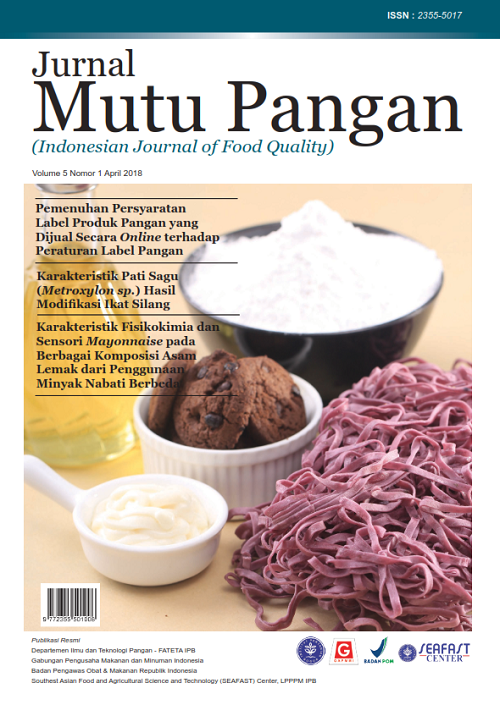Karakteristik Fisikokimia dan Sensori Mayonnaise pada Berbagai Komposisi Asam Lemak dari Penggunaan Minyak Nabati Berbeda
Abstract
Mayonnaise is an oil in water emulsion and used as condiment. Different vegetable oils used for mayonnaise production give different fatty acid compositions. The objective of this study was to determine physicochemical and sensory properties of mayonnaise in the use of different vegetable oils, by analyzing pH, color and viscosity as well as aroma and taste profiles by quantitative descriptive analysis. Sesame oil, palm oil, coconut oil, soybean oil, sunflower oil, a mixture (1:1)of coconut oil and sunflower oil or palm oil and soybean oil were used in formulations to give different compositions of polyunsaturated fatty acids (PUFA), monounsaturated fatty acids (MUFA) and saturated fatty acids (SFA). Mayonnaise characteristics including pH, color (L) and viscosity values which were ranged at 3.12–3.87, 87.47–89.58 and 3700–5513 cp respectively, were less associated to different fatty acid compositions. This also happened to sensory profiles. However principal component analysis result could map SFA/MUFA/PUFA with different characteristics of mayonnaise color, aroma and taste. Mayonnaise samples which correlated to PUFA had lighter color, and characteristics of oily taste and oil aroma, with the use of sunflower oil, meanwhile samples of soybean oil which also correlated to PUFA had the characteristics of mustard aroma, savory taste, acid taste, eggy aroma and mustard taste. MUFA correlated to sweet taste. Characteristics of lemon aroma was close to SFA with the use of coconut oil or its mixture. Therefore, color, aroma and taste of mayonnaise can be affected by the use of different fatty acid compositions.Downloads
References
Amertaningtyas D, Jaya F. 2012. Sifat Fisiko Kimia Mayonnaise dengan berbagai tingkat konsentrasi minyak nabati dan kuning telur ayam buras. J Ilmu-Ilmu Peternakan 21(1): 1-6.
Amin MH, Elbeltagy AE, Mustafa M, Khalil AH. 2014. Development of low fat mayonnaise containing different types and levels of hydrocolloid gum. J Agroaliment Proc Technol 20(1): 54-63.
[AOAC] Association of Official Analytical Chemists. 2012. AOAC Official Methods of Analysis. 19th Ed. Maryland (USA): AOAC International Press.
Basuny AMM, Al-Marzooq MA. 2011. Production of mayonnaise from date pit oil. Food Nutr Sci 2: 938-43. DOI: 10.4236/fns.2011.29128.
Collins YF, Mc Sweeney, Wilkinson MG. 2003. Lipo-lysis and free fatty acid catabolism in a cheese: a review of current knowledge. Int Dairy J 16: 1347-61. DOI: 10.1016/S0958-6946(03)00109-2.
Depree JA, Savage GP. 2001. Physical and flavor stability of mayonnaise. Trends Food Sci Technol 12: 157-63. DOI: 10.1016/S0924-2244(01)00079-6.
Fennema OR. 1996. Food Chemistry (3rd Ed). Marcel Dekker, New York. ISBN: 0-8247-9346-3.
Gorji SG, Smyth HE, Sharma M, Fitzgerald M. 2016. Lipid oxidation in mayonnaise and the role of natu-ral antioxidants: a review. Trends Food Sci Technol 56: 88-102. DOI: 10.1016/j.tifs.2016. 08.002.
Homma R, Yamashita H, Funaki J, Ueda R, Sakurai T, Ishimaru Y, Abe K, Asakura T. 2012. Identification of bitterness masking compounds from cheese. J Agric Food Chem 60: 4492-9. DOI: 10.1021/jf30 0563n.
Junaedi A. 2009 Principal Component Analysis (PCA) sebagai Salah Satu Metode untuk Mengatasi Masa-lah Multikolinearitas. [Skripsi]. Surabaya: Politek-nik Elektronika Negeri Surabaya-Institut Teknologi Sepuluh Nopember.
Kovalcuks A, Straumite E, Duma M. 2016. The effect of egg yolk oil on the chemical, physical and sensory properties of mayonnaise. Rural Sustain Res 35 (330): 25-31. DOI: 10.1515/plua-2016-0004.
Kris-Etherton PM, Innis S. 2007. Position of the ameri-can dietetic association and dietitians of canada: dietary fatty acid. J Am Diet Assoc 107: 1599-611.
Kupongsak S, Sathitvorapojjanan S. 2017. Properties and storage stability of O/W emulsion replaced with medium-chan fatty acid oil. Pol J Food Nutr Sci 67(2): 107-15. DOI: 10.1515/pjfns-2016-0015.
McClements DJ. 2005. Food Emulsions: Principles, Practices and Techniques. 2nd Ed. New York: CRC Press. ISBN: 0-8493-2023-2.
Meilgaard M, Civille GV, Carr TB. 1999. Sensory Evaluation Techniques. (3rd Ed). CRC Press, New York. ISBN: 9781439832271.
Munoz AM, Civille GV. 1998. Universal, product, and attribute specific scaling and the development of common lexicons in descriptive analysis. J Sens Stud 13: 57-76. DOI: 10.1111/j.1745-459X.1998.tb00 075.x.
Muslim A. 2014. Faktor-faktor yang mempengaruhi nilai impor kedelai Indonesia. Bul Ilmiah Litbang Perdagangan 8(1): 117-38.
Nazari B, Asgary S, Sarrafzadegan N. 2010. Warning about fatty acid compositions in some Iranian mayonnaise salad dressings. Int J Prev Med 1(2): 110-14.
Nikzade V, Tehrani M, Tarzjan MS. 2012. Optimization of low cholesterol, low fat mayonnaise formulation : Effect of using soy milk and some stabilizer by a mixture design approach. Food Hydrocoll 28: 344-52. DOI: 10.1016/j.foodhyd.2011.12.023.
O’Brien R. 2009. Fats and Oils: Formulating and Pro-cessing for Applications. 3rd Ed. CRC Press, New York. ISBN: 9781420061666.
Rahmawati D, Andarwulan A, Lioe HN 2015. Identi-fikasi atribut rasa dan aroma mayonnaise dengan metode quantitative descriptive analysis (QDA). J Mutu Pangan 2(2): 80-7.
Ritvanen TK. 2013. Ripened Cheese: The Effects of Fat Modifications on Sensory Characteristics and Fatty Acid Composition. [Dissertation]. Helsinki (FI): University of Helsinski. ISBN: 978-952-225-134-3.
Rutkowska J, Zbikowska A. 2010. Effects of fatty acid compostion of liquid margarines on sensory quality of cakes. Acta Aliment 35(2): 125-37. DOI: 10.1556/AAlim.39.2010.2.5.
Setyaningsih D, Apriyantono A, Sari MP. 2010. Analisis Sensori untuk Industri Pangan dan Agro. IPB Press, Bogor. ISBN: 9794932167.
Wardani NP. 2012. Pemanfaatan Eksrak Bunga Rosela (Hibiscus Sabdariffa L) Kaya Antioksidan dalam Pembuatan Mayonnaise Berbahan Dasar Minyak Kelapa, Minyak Sawit dan Minyak Kedelai. [Skripsi]. Bogor: Institut Pertanian Bogor.

















